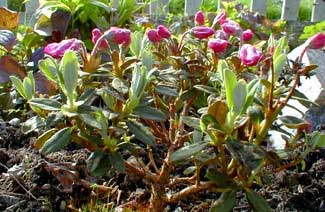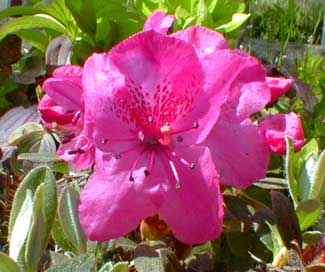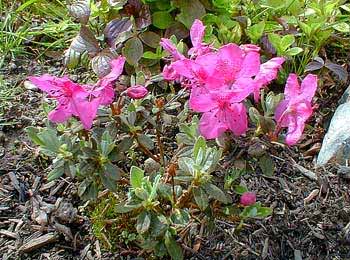
'Gigha' Dwarf Rhododendron
"Let the rain kiss you."
-Langston Hughes
(1902-1967)
(1902-1967)
There is considerable size variation in the small-leafed lepidote Rhododendron calostrotum, ranging in maturity from no taller than a few inches but sprawling (for the subspecies keleticum formerly separately classified as R. radicans), to variants like 'Gigha' which can reach one foot or rarely eighteen inches in ten years, or the suspecies riparium which can reach five feet.
This species provides some of the finest traits for dwarf evergreen rhodies developed by hybridizers, but ours is a naturally occurring variant of R. calostrotum ssp. calostrotum, a true species rhody. We planted an array of four little 'Gigha' shrubs on the morning-sun side of the chokecherry's dripline, where in time they should blend together forming a groundcover.
 'Gigha' is widely regarded as one of the finest of all dwarf evergreen rhodies, & I would certainly get in line to second that. It has been cultivated for gardens since 1971 & is a recipient of the Award of Garden Merit from the Royal Botanical Society. Its deep crimson flowers provide a color that is rare among dwarf lepidotes, the majority of which tend to be one or another shade of lavender.
'Gigha' is widely regarded as one of the finest of all dwarf evergreen rhodies, & I would certainly get in line to second that. It has been cultivated for gardens since 1971 & is a recipient of the Award of Garden Merit from the Royal Botanical Society. Its deep crimson flowers provide a color that is rare among dwarf lepidotes, the majority of which tend to be one or another shade of lavender.This variant's name is after the Isle of Gigha on the west coast of Scotland, a paradise for gardened alipine rhododedrons, with Achamore Gardens providing an on-line garden tour as particular proof.
I presume the island was so honored through the influence of the famed Scottish rhody grower Peter Cox, who has included the specific variant 'Gigha' in an extensive hybrid program for dwarf lepidotes at Glendoick Garden Centre. This little shrub obviously is not native to Gigha, but originates in alpine regions of Tibet, Yunnan China, upper Burma & northeast India.
The flowers are flattened crimson funnels occuring in groups of two or three. They can become so dense as to nearly hide the little shrub in April or May.
 The bright wrinkled buds are as bright as when they become opened flowers. The closed buds are shown in the photo at the top of the page, taken April sixth (2003). The open flowers were photographed less than a week later. Considering that our young specimens are no taller than the groundcover of bunchberries immediately behind them, 'Gigha' has quite a powerful presence.
The bright wrinkled buds are as bright as when they become opened flowers. The closed buds are shown in the photo at the top of the page, taken April sixth (2003). The open flowers were photographed less than a week later. Considering that our young specimens are no taller than the groundcover of bunchberries immediately behind them, 'Gigha' has quite a powerful presence.It's easily grown on Puget Sound, but would not like warmer areas. It is cold hardy to minus five degrees, but needs temperate summers & can be at considerable risk during heatwaves.
The bluish-green leaves are very fragrant, so that the combination of small size & appealing redolence demands it be situated near a garden path. The dripline of the chokecherry is at the edge of a little picnic spot, which is the only lawn we intend never to transform into more gardens, so that we can sit right there on grass next to this little shrub & give it our noses. Other redolent plantings along this location include 'Thalia' daffodils, & 'Blue Jacket' hyacintyhs.
For more photographs of this shrub, go to the:
'Gigha' Page of the Rhododendron Gallery